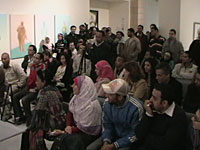Ministry of Culture, hereafter abbreviated as MoC.
Jessica Winegar, Creative Reckonings: The Politics of Art and Culture in Contemporary Egypt (Palo Alto, CA: Stanford University Press, 2006), 158, 161.
Boris Groys, “Politics of Installation,” e-flux journal, no. 2 (January 2009), →.
Only 101 artworks were selected out of a total of 1,293 submissions, as against the usual 300 or so.
“Salon al-shabab al-‘ishrun bayn al-tajdid wal-taqti‛a” (“20th Youth Salon: Between renewal and disruption”), Ruz al-Yusuf, April 12, 2009, 14.
For an overview of these criticisms, see Winegar, Creative Reckonings, 158–174.
Igor Zabel, “We and the Others,” Moscow Art Magazine 22 (1998) →.
See Saba Mahmood on Judith Butler’s discussion of the way in which theoretical formulations, purportedly universal and abstract, are “constitutively stained” by their examples, in Politics of Piety: The Islamic Revival and the Feminist Subject (Princeton: Princeton University Press, 2005), 163.
Such as the recently founded (2004) Contemporary Image Collective in Mounira, Cairo, “founded in 2004 by a collective of artists and professional photographers, focusing on the visual image and the development of contemporary visual arts and culture in Egypt.” See →.
The members of the 2009 Youth Salon Jury were Hend Adnan, Sahar El Amir, Bassam El Baroni, Hassan Khan, Mohamed Radwan, Moataz El Safty, Wael Shawky, and Ahmed Shiha (President of the Jury).
The panel took place the day after the official opening on March 30, 2009, and included: three of the members of the Salon jury committee, Bassam El Baroni, Hassan Khan, and Wael Shawky; Mohammed Tala’at, the director of the Ministry of Culture’s Palace of Arts; the head of the jury committee, Ahmed Shiha; and the head of the Fine Arts Sector in the Egyptian Ministry of Culture, Mohsen Sha’alan.
Samar Nawar, “Al-mustab‛idun min salon al-shabab yuftahun al-nar ‛ala lajnat al-tahkim wa wizarat al-thaqafa”[“The Refusés of the Youth Salon open fire on the jury committee and the Ministry of Culture”], Al-Badil, April 2, 2009, 12; Fatima Ali, “Salon ‘lajnat al-tahkim’ wa laysa ‘salon al-shabab’,” &leftbracket;The ‘Jury Committee Salon’, not the ‘Youth Salon’”&rightbracket;, Al-Qahira, April 14, 2009; Salah Bisar, “Salon al-shabab al-ishrun…dawra dun al-mustawa,” &leftbracket;“20th Youth Salon…A session without quality”&rightbracket;, Al Qahira, April 21, 2009, 15; “Salon al-shabab al-‘ishrun bayn al-tajdid wal-taqti‛a” &leftbracket;“20th Youth Salon: Between renewal and disruption”&rightbracket;, Ruz al-Yusuf ; Dina Sadiq, “Dawra bahta min salon al-shabab” &leftbracket;“A perplexing session from the Youth Salon”&rightbracket;, Al-Shuruq Al-Jadid, April 6, 2009, 12.
Groys, “Politics of Installation.”
Zabel, “We and the Others.”
Coexisting cultural levels could then, through synchronic analysis, be ordered diachronically, within the framework of a universal “world history.” See Reinhart Koselleck, Futures Past: On the Semantics of Historical Time, trans. Keith Tribe (Cambridge, MA: MIT Press, 1985), 231-288.
See, for example, Laura U. Marks, “What is That and Between Arab Women and Video? The Case of Beirut,” Camera Obscura 18, no. 3 (2003), 43–44.
I am using the term “counter-public” discourse to refer to practices that are oppositional to normative hegemonic public art discourse in Egypt, which focuses on the creation of a contemporary artistic movement that is rooted in a (national) identity-based sensibility.
I thank Brian Kuan Wood for bringing this point to my attention.
Groys, “Politics of Installation.”
Timothy Mitchell, Rule of Experts: Egypt, Techno-politics, Modernity (Berkeley and Los Angeles: University of California Press, 2002), 10.
The period of state socialism in Egypt is usually designated as 1952–1970. Economic liberalization is said to have begun with Sadat’s 1974 “open door” economic liberalization policy. Jason Read develops Foucault’s idea of homo-economicus as defined by an anthropology of competition (rather than exchange, as in classical liberalism) in “A Genealogy of Homo Economicus: Neo-Liberalism and the Production of Subjectivity,” Foucault Studies 6 (February 2009), 25–36.
The phrase “total creative freedom” was used in the introductory essay of the Salon’s catalog by Commissioner George Fikry, and was part of the open call that was sent out for the annual competition.
Usama Afifi, quoted in “Salon al-shabab al-‘ishrun bayn al-tajdid wal-taqti‛a.” See also Nawar, “Al-mustab‛idun min salon al-shabab yuftahun al-nar.”
See Alexei Yurchak, Everything Was Forever Until It Was No More: the Last Soviet Generation (Princeton: Princeton University Press, 2006), 10–14, on Lefort’s paradox of socialist ideology, exemplified in the “objective of achieving the full liberation of society and individual . . . by means of subsuming that society and individual under full party control.” See his discussion of the book Marxist-Leninist Theory of Culture and the idea that “in the socialist context, the independence of creativity and the control of creative work by the party are not mutually contradictory but must be pursued simultaneously” (12).
Winegar, Creative Reckonings, 156.
Read, “A Genealogy of Homo-Economicus,” 26–32.
Hannah Feldman and Akram Zaatari, “Mining War: Fragments from a Conversation Already Passed,” Art Journal 66, no. 2 (2007): 50.
Bisar, “Salon al-shabab al-ishrun…dawra dun al-mustawa.”
Bisar, “Salon al-shabab al-ishrun…dawra dun al-mustawa;” “Salon al-shabab al-‘ishrun bayn al-tajdid wal-taqti‛a.”
Igor Zabel, “We and the Others.”
Images of panel discussion courtesy Mona Gamil.
